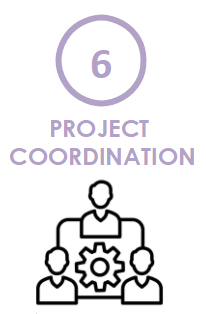The PHOSTER project is composed by 5 technical work packages (WPs),

- WP1 : re-design of mono-incineration process
- WP2: optimisation of selective phosphorus extraction avoiding contamination from undesired metals and metalloids
- WP3: identification and preparation of mining by-products rich in magnesium
- WP4: development of a selective co-precipitation process for the recovery of high-value nutrient-rich material
- WP5: technical and sustainability assessment of the recovered products and the production process guiding the eco-design methodology
- WP6: project management and dissemination actions, risk assessment and mitigation, stakeholder involvement, technology transfer
WP1
WP1 aims to re-design the sewage sludge thermal treatment by positioning the recovery of secondary materials as the first priority design parameter.
This for the first time introduces demand-driven design for which a hybrid, numerical-experimental approach will be required. With the aim to achieve the highest impact and highest possible relevance, the focus will be on majorly utilized fluidized bed technology, made available by MM on pilot-scale.
To decouple the re-design process from particular bed type, exploratory actions are envisaged also in a fixed bed technology, available at the University of Ljubljana on prototype-level.
Extending beyond typical incineration conditions, several degrees of freedom will be investigated: from local thermodynamic parameters (sludge retention time, stoichiometric ratios) to different sludge compositions, pre-treatment type and moisture content. With extensive mapping of operational space via Design of Experiments (DoE) and Response Surface Methodology, high-sensitivity areas of the experimental matrix will be pinpointed.
Primary data on all relevant ash properties (morphology, composition, heavy-metal and residual organic content, porosity…) will be obtained in cooperation with WP2 (Politecnico di Milano), with which the feedback loop for the first phosphorus-recovery oriented optimization of the incineration process will be established.
Parametric relations between downstream process efficiency and thermal treatment conditions will then serve as a basis for development of innovatively designed, physically consistent modelling framework, which will allow to evaluate the impact of incineration parameter adjustments to emission response, performance and overall combustion dynamics – a key to making the redesigned process transferrable and scalable across a wide range of devices.
By coupling the bed models to novel freeboard combustion models, previously developed by the team of University of Ljubljana, the stand-alone solution for developers and operators of thermal treatment systems as well as for assessment of in-project developed value chain will be delivered. Insensitive of sludge composition, combined with first systematic and structured database for relation between thermal treatment process and phosphorus extraction efficiency, the modelling framework will also be crucial for evaluation of the overall lifecycle performance of integrated co-precipitation of nutrients and final recovered products.
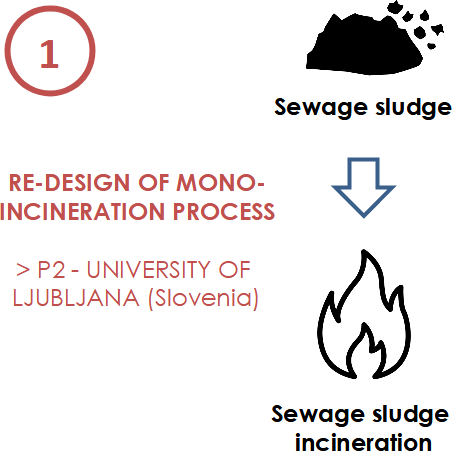
WP2
WP2 aims at optimising existing procedures for wet chemical extraction by acid leaching to ensure both a high dissolution of phosphorus and a low dissolution of undesired metals and metalloids.
The influence of operating conditions (type and concentration of leaching acid, solid-to-liquid ratio, reaction time) on phosphorus and undesired elements extraction performance will be systematically explored by chemometrics and advanced statistical techniques in close continuity with the optimisation of the mono-incineration process (WP1), as this thermal treatment is expected to strongly affect SSA characteristics and thus the solubility of desired and undesired elements.
Therefore, the WP2 activity conducted at Politecnico di Milano is also addressed at unravelling the relation between process performance and operating conditions applied for wastewater and sludge treatment, even including the mono-incineration step, so as to identify the most suitable process operating conditions based on SSA characteristics, considering wastewater and sludge treatment as one with the recovery process.
Therefore, a specific goal of WP2 is to identify simple and easily available indicators for guiding the wet chemical extraction based on SSA and system characteristics.
In this regard, a focal point for minimising SSA leachate contamination will consist in the investigation of strategies to apply during the mono-incineration resulting in a better immobilization of contaminants (possibly involving process temperature or SSA cooling kinetics).
A further relevant focus of WP2 is to methodically investigate additional process parameters besides phosphorus extraction efficiency and contaminant release, as the consumption of reagents and the amount of waste generated, in order to collect all relevant information for conducting process sustainability assessment and identifying production process optima. As a closing WP2 activity, some preliminary lab-scale tests are performed for assessing the implementation of a semi-continuous wet chemical extraction process, in the view of identifying promising parameters for industrial application under optimal operating conditions, possibly minimising the amount of leaching agent.
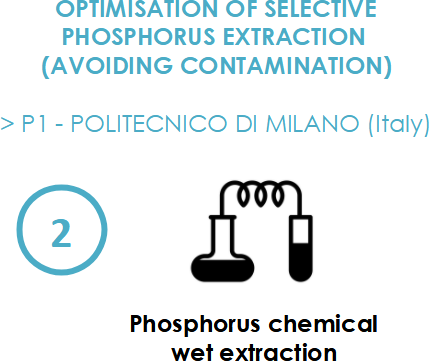
WP3
WP3 aims at mining by-products selection along the production process, characterization and pre-treatment to provide optimised input materials for the co-precipitation process.
In detail, magnesia (MgO) based by-products from the mining industry differ in granulometry (grain size distribution, specific surface) and composition (MgO and other oxides and minerals). Various pre-treatment alternatives will be tested at the Magna facilities. A reduction in the particle size up to nanometric size (100-300 nm) will be applied to increase specific surface and, thus, to improve reaction velocity due to the higher surface contact between the reactants.
Two different methods will be tested to reduce the particle size: dry milling and wet milling. In a second route, size reduction will be performed in conjunction with an additional action: surface functionalization by chemical coating and wetting agents, leading to a better dispersion of the MgO in the media and, therefore, to higher overall reactivity.
The selection of best by-products candidates and pre-treatment procedures will be made according to the best efficiency in magnesium and phosphorus recovery and considering the final use as fertilizer, therefore promoting compositions enriched in nutrients and avoiding contaminated.
Accordingly, WP3 will be conducted in close continuity with WP4 by means of the feedback loop optimisation methodology.
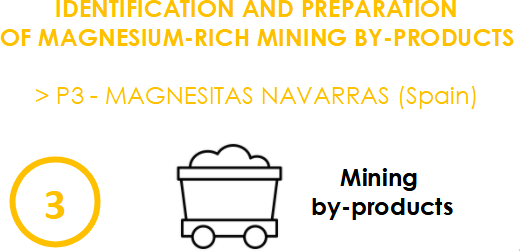
WP4
WP4 aims at the phosphorus co-precipitation of waste and by-product streams by the addition of precipitating agents, since it has been a poorly-studied critical stage of the whole process of phosphorus recovery.
The goal of WP4 is the identification of optimal operating conditions (characteristics and concentration of reagents and precipitating agent(s), pH, aging period, solid-liquid separation conditions) to obtain solid nutrient-rich compounds with desired characteristics (nutrient concentration, purity, morphology and crystalline structure, chemical-physical characteristics), being calcium and magnesium phosphates or (k-)struvite possible recovery targets.
Primarily, the differences in precipitation behaviour between phosphorus and contaminants will be exploited to promote process selectivity by applyingaccurate process control strategies.
In particular, the importance of some operating conditions, as pH and aging period, on contaminant precipitation and thus recovered products characteristics were observed in preliminary experiments (data under publication) conducted by Politecnico di Milano, indicating it as a promising solution to improve recovered product purity. Secondly, since reagents characteristics and concentration (SSA leachate, pre-treated mining by-products) are expected to act as major affecting factors for the recovery process output, with a strong influence of processes investigated in WP1 and WP3, the holistic approach in production process assessment will once again represent a key element in identifying optimal conditions.
In addition as an innovative low-cost and low impact strategy to prevent recovered product contamination, the dosage of stabilising reagents during the precipitation phase will be investigated for preventing metals and metalloids precipitation and increasing process selectivity. As in case of WP2, experimental design will be structured based on chemometrics and advanced statistical techniques, and the dosage of reagents will be performed by highly-accurate automatic titrators to improve process control. The expected outcome of WP4 is the identification of optimal operating conditions for selective and sustainable co-precipitation stage.

WP5
WP5 aims at the selection of the best formulation to obtain a high-quality recovered material.
The mixing and granulation of the recovered products with other raw materials in a fertiliser formula will be assessed as well as their physical-chemical characteristics by adapting the established know-how on fertiliser manufacturing.
Different formulations will be tested, in the view of reproducing a spectrum of commercial products. Formulated products will undergo a thorough quality assessment to check the fertilising properties and the compliance with European standards to be marketable, such as humidity, pH, solubility test, friability, macro-, meso-, and micro-nutrients content and heavy metals thresholds.
Most relevant formulas will be subjected to a Social Life Cycle Assessment (SLCA) to evaluate environmental and social impacts of fertilisers from recovered products in comparison with conventional fertilisers having equivalent composition. In order to provide a complete sustainability evaluation, such assessment procedure will be extended to the whole production process, including elements related to the management of process residues.
Subsequently, SCLA results will be used as inputs for a Cost-Effectiveness Analysis (CEA).
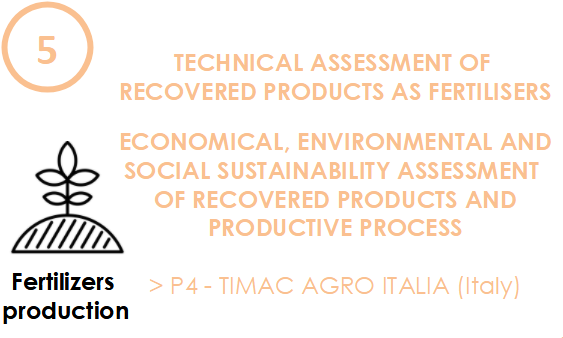
WP6
WP6 is specifically devoted to some non-technical actions. Many of these tasks are essential elements for the development of the eco-design methodology for circular solution design and verification, and thus for the successful achievement of project goals.
- Project management is a key aspect for the effective application of the PHOSTER methodology implying continuous synergic cooperation among project partners and stakeholders. Project management actions will be defined in the early phases of the project, as well as a monitoring plan based on KPIs for the continuous verification of milestones and the quick detection of critical issues.
- Risk assessment and mitigation will be crucial for facing critical issues that are expected from the interrelated and non-linear structure of the PHOSTER project. These tasks will be carried out in close continuity with project management, according to the plan detailed in the following.
- Stakeholder involvement will be a fundamental part of the PHOSTER project. The relation with stakeholders, including extra-consortium ones, will be structured in the early phases and maintained throughout the project by creating an Advisory Board in charge of supporting the progressive verification of project advancements and participating in dissemination and technology transfer initiatives.
- Project dissemination targeted on various relevant stakeholders (research institutes, technology providers, water utilities, agrochemical industries, policymakers, civil population) at various scales (local, national and international), representing a crucial element in fostering solution diffusion.
- Technology transfer will be carried out through all phases of the project by preparing a dedicated deliverable in which emerging technological elements are progressively integrated. Therefore, the expected output will consist in the provision of elements for prototyping, including relevant KPIs (Key Performance Indicators) related to process parameters (operating costs, reagent consumption, …) and essential for subsequent technology advancement (process scale-up, business development, …).
